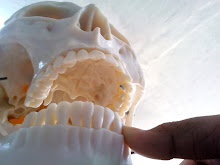Dental Histology is a very interesting subject but initially many students face a lot of problem understanding it.I can say this as I have been through this phase but don't worry, I'll try to make it easy for you and I hope you like my effort :)
We'll study development of teeth under the following headings-
1.FORMATION OF DENTAL LAMINA
2.STAGES IN TOOTH DEVELOPMENT- (a)Bud stage
(b)Cap stage
(c)Bell stage- ( c.1) Early bell stage
(c.2) late bell stage
In this post we'll study formation of dental lamina.
Where are your teeth present? In your mouth obviously :D
So imagine yourself in your mothers womb okay... So you are just developing right.. and so is your mouth or oral cavity. Now this oral cavity (which is in the process of development) is called PRIMITIVE ORAL CAVITY or STOMODEUM and it is lined by stratified squamous epithelium. And we'll call this epithelium ORAL ECTODERM.
This ORAL ECTODERM contacts the ENDODERM (of the foregut) by a BUCCOPHARYNGEAL MEMBRANE.
Here's a pic that will help you visualize this-
At the 27th day of pregnancy the buccopharyngeal membrane ruptures and the primitive oral cavity establishes a connection with the endoderm of the foregut (Fig2) -
Underlying the oral ectoderm we have a connective tissue and most of these connective tissue cells are ectomesenchyme in origin (Fig3) These cells are though to instruct the ectoderm to start tooth development. And the development of tooth first occurs in the the anterior portion of future maxilla & mandible (We call it 'Future maxilla & mandible' because they haven't developed yet)
NOTE- In the diagram, within the ectomesenchyme the lines represent the collegen fibres but their orientation might not be correct in the above pic because I made it in a hurry & forgot to consider this.Sorry for this mistake!
Now we arrive at 'DEVELOPMENT OF DENTAL LAMINA'
Remember the buccupharyngeal membrane ruptured at 27th day of gestation? So 2 or 3 weeks after the rupture of this membrane certain areas of the basal cell of the oral ectoderm proliferate more rapidly (Fig.4) This leads to the formation of primary epithelial band (Fig 5)
DENTAL LAMINA- Will form the ectodermal portion of deciduous teeth. The permanent successors will arise from the LINGUAL extension of dental lamina & Permanent molars will arise from its DISTAL extension. (Now you'll have to cram it :P )
VESTIBULAR LAMINA- Forms the vestibule of the mouth
(WHAT IS VESTIBULE??
Put your tongue in between your gums and cheeks. You find a space there right? That is the vestibule)
FATE OF DENTAL LAMINA-
Another boring note- The diagrams above are just for your visualization & you should make standard diagrams in your exams (diagrams from your book) to get good marks.
Hey before you leave,Did you understand it? Please leave your comments below :)
We'll study development of teeth under the following headings-
1.FORMATION OF DENTAL LAMINA
2.STAGES IN TOOTH DEVELOPMENT- (a)Bud stage
(b)Cap stage
(c)Bell stage- ( c.1) Early bell stage
(c.2) late bell stage
In this post we'll study formation of dental lamina.
Where are your teeth present? In your mouth obviously :D
So imagine yourself in your mothers womb okay... So you are just developing right.. and so is your mouth or oral cavity. Now this oral cavity (which is in the process of development) is called PRIMITIVE ORAL CAVITY or STOMODEUM and it is lined by stratified squamous epithelium. And we'll call this epithelium ORAL ECTODERM.
This ORAL ECTODERM contacts the ENDODERM (of the foregut) by a BUCCOPHARYNGEAL MEMBRANE.
Here's a pic that will help you visualize this-
 |
| Figure 1 |
 | |
| Fig.2.The ectoderm contacts the endoderm after the rupture of buccupharyngeal membrane |
Underlying the oral ectoderm we have a connective tissue and most of these connective tissue cells are ectomesenchyme in origin (Fig3) These cells are though to instruct the ectoderm to start tooth development. And the development of tooth first occurs in the the anterior portion of future maxilla & mandible (We call it 'Future maxilla & mandible' because they haven't developed yet)
 |
| Figure 3 |
Now we arrive at 'DEVELOPMENT OF DENTAL LAMINA'
Remember the buccupharyngeal membrane ruptured at 27th day of gestation? So 2 or 3 weeks after the rupture of this membrane certain areas of the basal cell of the oral ectoderm proliferate more rapidly (Fig.4) This leads to the formation of primary epithelial band (Fig 5)
 |
| Fig4.Proliferation of basal cells of oral ectoderm |
 |
| Fig 5.Primary epithelial band |
This primary epithelial band divides into inner lingual and outer buccal process.The lingual process is called Dental Lamina and outer Buccal process is called vestibular lamina (Fig6)
 |
| Fig6.Dental Lamina & vestibular lamina |
 |
| This how the dental Lamina and vestibular lamina looks |
VESTIBULAR LAMINA- Forms the vestibule of the mouth
(WHAT IS VESTIBULE??
Put your tongue in between your gums and cheeks. You find a space there right? That is the vestibule)
FATE OF DENTAL LAMINA-
- Total activity of dental lamina extends for the period of 5 years.
- Dental lamina may still be active in the third molar region after it has disappeared elsewhere.
- Remnants of dental lamina persist as epithelial pearls or islands within the jaw and gingiva and these remnants are called rest of Serres
Another boring note- The diagrams above are just for your visualization & you should make standard diagrams in your exams (diagrams from your book) to get good marks.
Hey before you leave,Did you understand it? Please leave your comments below :)















